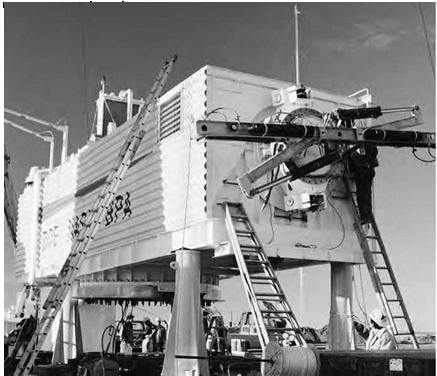Second-Generation DOE-NASA Wind Turbine Systems (Mod-2)
While the primary objectives of the Mod-0, Mod-0A, and Mod-1 programs were research and development, the primary goal of the second-generation Mod-2 project was for direct and efficient commercial application. The Mod-2 program was designed to determine the potential cost-effectiveness of megawatt-sized remote site operation wind turbines when located in areas of moderate (14 mph) winds. Significant changes from the Mod-0 and Mod-1 included use of a soft-shell-type
 |
|
tower, an epicyclic gearbox, a quill shaft to attenuate torque and power oscillations, and a rotor designed primarily to commercial steel fabrication standards. Other significant changes were the switch from fixed to a teetered (pivot connection) hub rotor, which reduced rotor fatigue, weight, and cost; use of tip control rather than full span control; and orienting the rotor upwind rather than downwind, which reduced rotor fatigue and resulted in a 2.5-percent increase in power produced by the system. Each of these changes resulted in a favorable decrease in the cost of electricity. One of the more important changes, as noted in a Boeing conference presentation, was the switch from the stiff truss type tower to a soft shell tower that weighed less, was much cheaper to fabricate, and enabled the use of heavy but economical and reliable rotor designs.[1505]
Four primary Mod-2 wind turbine units were designed, built, and operated under the second-generation phase of the DOE-NASA program. The first three machines were built as a cluster at Goldendale, WA, where the Department of Energy selected the Bonneville Power
 |
|
Administration as the participating utility. The operation of several wind turbines at one site afforded NASA the opportunity to study the effects of single and multiple wind turbines operating together while feeding into a power network. The Goldendale project demonstrated the successful operation of a cluster of large NASA Mod-2 horizontal-axis wind turbines operating in an unattended mode within a power grid. For construction of these machines, DOE-NASA awarded a competitively bid contract in 1977 to Boeing. The first of the three wind turbines started operation in November 1980, and the two additional machines went into service between March and May 1981. As of January 1985, the three – turbine cluster had generated over 5,100 megawatthours of electricity while synchronized to the power grid for over 4,100 hours. The Mod-2 machines had a rated power of 2.5 megawatts, a rotor-blade diameter of 300 feet, and a hub height (distance of the center of blade rotation to the ground) of 300 feet. Boeing evaluated a number of design options and tradeoffs, including upwind or downwind rotors, two – or three-bladed
rotors, teetered or rigid hubs, soft or rigid towers, and a number of different drive train and power generation configurations. A fourth 2.5-megawatt Mod-2 wind turbine was purchased by the Department of the Interior, Bureau of Reclamation, for installation near Medicine Bow, WY, and a fifth turbine unit was purchased by Pacific Gas and Electric for operation in Solano County, CA.[1506]










